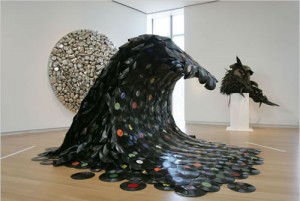Immediate Response
After scouring books for interesting and appealing contemporary sculptures, I came across this piece by Jean Shin, a female Korean artist who is known for making sculptures out of recycled materials. What struck me at first was the size of the sculpture and the blackness of the piece. At first, I didn’t even realize that it was made of old vinyl records, but once I did, the name “Sound Wave” made a lot more sense. I love the use of recycled records, especially in an age where not many people listen to records anymore, with the inventions of the mp3 player and computer; etc…Shin’s use of the vinyl records is clever and thought provoking.
Objective Description
A pile of black, vinyl records lay neatly on the hardwood floor of The Museum of Art and Design’s exhibit of “Second Lives: Remixing the Ordinary”. The pile gets larger towards the back and some of the vinyl records have been melted to be able to curve upward in the shape of a ocean wave. The wave is curving up high and over the pile on the ground and is about the crash. Although each record is dark black, there is a small section in the middle of each record that has a different color, ranging from green, to yellow, to white, to red, to blue.
Technical Decisions
Jean Shin used recycled and outdated vinyl records for this piece. This technical decision is common throughout her works as she commonly resorts to using recycled materials. In order to provide the distinct, watery shape to her wave of records, she melted most of them down and bent them to her satisfaction. The structure is large, and is oriented on the hardwood floor, which gives the viewer the sense that the wave is emerging from the gallery floor.
The Work in the World
Sound Wave connects with almost everybody that listens to music. Whether it is from the vinyl record generation, or the iPod generation, whether you listen to classical jazz or hardcore rap, everyone knows what it feels like when a great song blasts through your speakers or headphones and into your ears. That’s what Shin is showing with the piece and she is able to connect to everyone who sees the piece of art. At first glance, someone might attribute this piece to connect to the ocean or something about surfing, however it actually has nothing to do with that. The wave serves as a metaphor, and once the vinyl records are observed, the connection with music is made.
The Story It Tells
Jean Shin was quoted saying how this sculpture connotes “the inevitable wave of technology that render each successive generation of recordable media obsolete”. Her technical decisions also speak loudly to her message, since she melted down hundreds of vinyl records for the construction of this project. Shin’s use of the records show just how obsolete vinyl records have become, when only 30-40 years ago they were the “in” media outlet for music. The meaning of Sound Wave is to show how a major source of music can rise up high, and then crash down hard, just like a wave.

